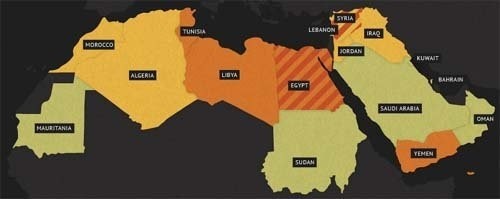(VOVworld) – It’s been two years since the Arab Spring broke, shaking the Muslim world. Contrary to initial expectations, the only things the revolution has brought countries in the Middle East and North Africa are political instability, social division, and economic decline. VOV editor Hong Van comments:
 |
| The map shows instability in the Middle East caused by the Arab Spring revolution. The level of seriousness is on the rise from light to dark yellow. (Photo: RIA) |
Instability, division, and sectarian contradiction describe the situation in the Middle East and North Africa over the past two years. In many places, people have taken to the streets to protest the governments they themselves elected because the new administrations have failed to make any positive changes. The public and their governments are opponents despite the promise of democracy and justice which was the heart of the Arab Spring. Egypt is a typical example of this disappointment. Demonstrations have been continuous since President Hosni Mubarak was toppled, dragging down the country’s economy and tourism. Debates have regularly taken place over the withdrawal of the Supreme Council of the Armed Forces, the election of a new Parliament and President, the dismissal of the Parliament, and the adoption of a new constitution. Political tensions in Egypt have cut its foreign reserve in half, increased the unemployment rate, and ballooned the state budget deficit to 27.5 billion USD.
Syria is another nation that has been devastated by the Arab Spring. The escalation of a conflict between President Bashar Al-Assad and opposition forces has claimed more than 42,000 lives. The civil war has turned Syria into a chaos of ethnic groups, political factions, and even world powers scrambling to gain their influences. Meanwhile living conditions in Syria have steadily worsened. The UN has warned that a possible famine could leave one million Syrians on the brink of starvation this winter. Millions of Syrians have already left their homes to seek refuge in neighboring countries.
It’s no better in Libya. Although a democratic election was held after Gaddafi was ousted, a struggle for power between the newly established government and armed militias continue to hinder Libya on the path to stability. Tens of thousands of Libyans continue to flee. Last September’s attack on the US Consulate in Benghazi which claimed the lives of four Americans including Ambassador Chris Stevens was tragic evidence for this instability. This was a consequence the US couldn’t anticipate when it supported the Arab Spring.
Tunisia, where the Arab Spring began, is now facing instability, increased unemployment, spreading corruption, and the rise of Islamic extremist organizations. A state of emergency has been declared in this country.
A recent IMF report said that most economies in the Middle East and North Africa will recover only slowly this year with high inflation and unemployment rates. The average GDP growth in Egypt, Tunisia, and Yemen is estimated to be 3.6%, much lower than the 4.7% in 2010 before demonstrations broke out. The IMF also predicts that the decline of the currencies of these countries is likely to raise this year’s inflation to 8.6%, the highest level since 2008.
Analysts say 2013 will not bring about brighter hopes to Egypt, Syria, Tunisia, and Libya. This is an unexpected consequence left by what international observers call ‘Arab Spring’.
Hong Van